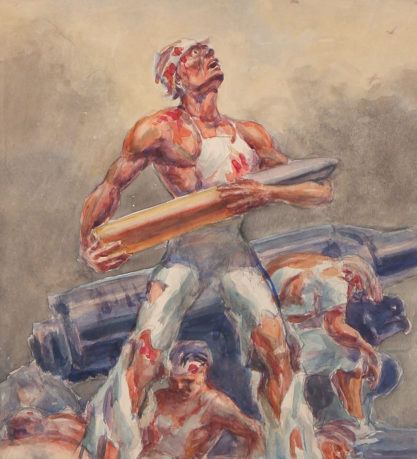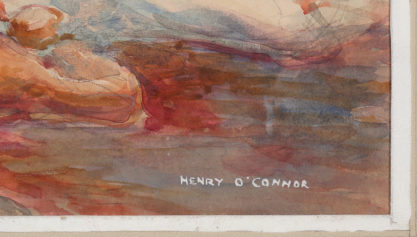

A stirring WWII battle scene describing the horrors of war and the individual’s heroic reckoning with certain death and the ‘never-back-down’ mentality of American spirit.
The following biography is courtesy of AskART and is an edited version of the monograph written by Gary Kraidman, Henry Michael O’Connor (1891-1975): A Rediscovered American Artist. Submitted by Meghan Read, Childs Gallery, Boston:
Henry Michael O’Connor was born in Brookline, Massachusetts on March 5, 1891. Early references allude to O’Connor’s skill as a boxer, a favorite sport and source of revenue for his education. He studied at the Massachusetts Normal Art School in Boston and the Boston Museum of Fine Arts School under teachers such as Joseph Pennell, Joseph de Camp, and Frank Benson. O’Connor also assisted Abbot Thayer in Dublin, New Hampshire for two years who then encouraged the young artist to go abroad. In Europe, he studied at the Académie Julian in Paris and practiced etching at the Kensington School in London.
Early in his career, O’Connor seems to have been influenced by the Ashcan School of Realists in New York, although he remained active in Boston. The working people and sites of Salem Street in Boston’s North End was a favorite early subject of which he made mostly drawings. His fluid and precise linear quality is evident in several of the early drawings dating from 1914 to1919, which depict working class scenes from Charlestown, Gloucester, and Rockport in addition to Boston. Urban monuments and architecture became more frequent subjects in subsequent works. Some Boston landmarks depicted by O’Connor include Faneuil Hall, State Street, the Massachusetts State House, Harvard, Paul Revere’s House and Trinity Church.
Two lithographs dated 1918 provide the first evidence of O’Connor’s activity in New York, although the main body of his New York work begins in the 1920’s. Shortly after the First World War ended, O’Connor opened a studio in the city and soon met Regina Summer, a New York City designer, whom he married in 1924. Due to frequent visits, he was still listed as a Cambridge resident into the 1930’s while he lived and worked in New York City. One of his New York etchings, “Looking from New Jersey to New York” was similarly portrayed by Joseph Pennell and Martin Lewis. O’Connor is also known to have spent time working in Paris in the early 1920’s. Four Parisian etchings appeared at the National Academy of Design in New York City in the 1927 Annual Exhibition.
Much of O’Connor’s graphic work reflects his frequent travels. Some of his known trips include Gloucester (MA), Rockport (MA), Philadelphia, Chicago, Memphis, Indianapolis, Paris, London, Nuremberg, Dresden, Rotterdam, Venice, Florence, Siena, and several Canadian cities.
As shown in countless prints and drawings, O’Connor was also an avid marine enthusiast. He shared this interest with friend and author Jim Connolly and provided illustrations for two of his volumes, “The Book of Gloucester Fishermen” (New York: The John Day Company, 1927) and “Navy Men” (New York: The John Day Company, 1939). He also designed the cover for the November 1938 issue of ASIA, published by the American Asiatic Foundation. His affiliation with the naval community as a petty officer earned him a portrait painting commission for six naval officers in NACAL. A portrait of Admiral Charles Wellborn Jr. may be located at the United States Naval College in Norfolk, Virgina.
Other O’Connor sitters include Franklin Delano Roosevelt, Governor Charles Hurley, Dr. William O’Hanlon (reportedly located at the Margaret Hague Hospital in Jersey City, New Jersey) the Honorable Joseph Tallent, and James Roosevelt. The Roosevelt picture was reported to be somewhere in Boston, Massachusetts*.
Henry O’Connor died suddenly on February 25, 1975. Funeral services were held in Cambridge Massachusetts, and he may have been buried at the site of the Lakewood Cemetery Association.
*It is not clear whether this refers to the James or Franklin D. Roosevelt portrait
MEMBERSHIPS:
American Irish Historical Society
American Legion
Artist’s Aid Society (Artist’s Fellowship), President
Boston Art Club
Boston Society of Etchers
Brooklyn Society of Etchers (Society of American Graphic Artists)
Catholic Institute of the Press
Chicago Society of Etchers
Copley Society
Elks Club
Los Angeles Society of Etchers
Philadelphia Water Color Club
Provincetown Art Association
Salmagundi Club (President, 1946-7)
Washington Print Club
AWARDS:
American Institute of Graphic Arts, Awarded First Prize with James Connelly for The Story of the Gloucester Fishermen, 1927
Sesqui-Centennial Exhibition, 1926 Philadelphia
EXHIBITIONS/COLLECTIONS:
Exhibited at The National Academy of Design, 1927; The artist’s work may be found at the Massachusetts State Capitol, the New Jersey Medical Center, Harvard University, and the Newark Museum.



